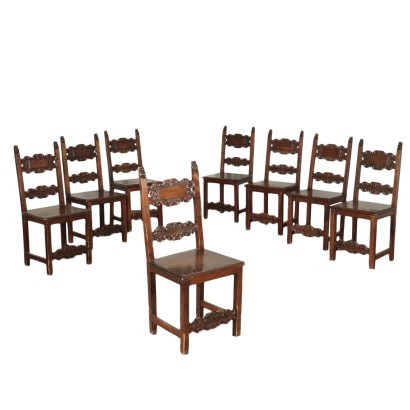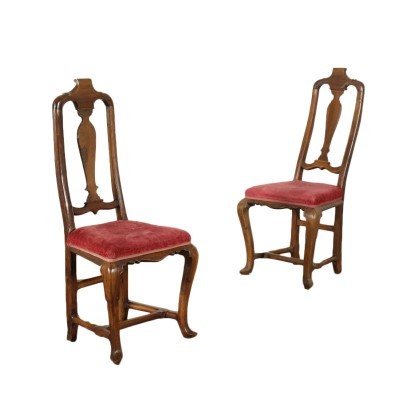Group of 8 Neo-renaissance Style Chairs Walnut Chestnut 20th Century
Features
Style: Neo-Renaissance Revival
Age: 20th Century / 1901 - 2000
Origin: Italy
Main essence: Chestnut , Walnut
Description
Supported by legs connected by crossbeams of which the frontal one is carved with plant patterns that are also engraved on the back. Walnut, chestnut seat.
Product Condition:
Fair condition. Wear consistent with age and use.
Dimensions (cm):
Height: 110
Width: 49
Depth: 43
Seat height: 53
Additional Information
Style: Neo-Renaissance Revival
Stylistic revival, from the 1900s, of the forms typical of the Renaissance style.This is a style that re-proposes, looking at the grandeur of the past, decorative motifs and decorations typical of the 1500s.
Mascheroni, cornices, columns carved with herms that make up typical architectural structures of Renaissance palaces, are the elements that characterize the Neo-Renaissance style.
These elements will remain in the production of furniture until the early 1900s, contaminating themselves with floral elements.
Find out more about the Neo-Renaissance with our insights:
A Milanese library between the Belle Epoque and Fascism
Age: 20th Century / 1901 - 2000
20th Century / 1901 - 2000Main essence:
Chestnut
It is a hard, yellow-white wood, mostly used for rustic furniture. Since the Middle Ages it has been used in Europe, mainly in Spain, France and Italy. Particularly resistant, it was sometimes used to manufacture the supporting structures of fine furniture. It tends to darken over time and has good resistance to woodworms.Walnut
Walnut wood comes from the plant whose botanical name is juglans regia , probably originally from the East but very common in Europe. Light or dark brown in color, it is a hard wood with a beautiful grain, widely used in antique furniture. It was the main essence in Italy throughout the Renaissance and later had a good diffusion in Europe, especially in England, until the advent of mahogany. It was used for solid wood furniture and sometimes carvings and inlays, its only big limitation is that it suffers a lot from woodworm. In France it was widely used more than anything else in the provinces. In the second half of the eighteenth century its use decreased significantly because mahogany and other exotic woods were preferred. Alternative proposals























